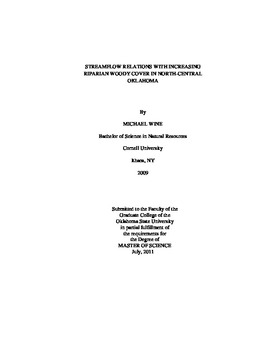| dc.contributor.author | Wine, Michael Louis | |
| dc.date.accessioned | 2014-04-15T22:32:01Z | |
| dc.date.available | 2014-04-15T22:32:01Z | |
| dc.date.issued | 2011-07-01 | |
| dc.identifier.uri | https://hdl.handle.net/11244/9578 | |
| dc.description.abstract | The study was conducted in the Council Creek watershed in Payne County, Oklahoma using historical data from 1938-1992. Historical aerial photographs were obtained and georeferenced, masked, and mosaicked to the Council Creek watershed. A semi-automated processing procedure was developed using Model Builder in ArcGIS 10. Maximum likelihood classification, a supervised classification method, was used to initially classify each pixel within images of the watershed as either woody or as one of several background categories. The individual pixels were then processed using an algorithm to convert areas greater than 1,000 m2 classified as woody to polygons. These polygons were then individually examined and areas that appeared to have been misclassified were corrected. Statistical methods were then used to determine which among potential evapotranspiration, woody cover, and precipitation best predicted changes in streamflow and its components. Significant increasing trends of precipitation, streamflow duration and baseflow were uncovered, though total streamflow did not change significantly. Woody cover increased from 5% in 1938 to 18% in 1992, driven primarily by increases in deciduous trees. Eastern redcedar canopy cover never comprised more that 15% of total woody cover. Baseflows were directly related to precipitation and woody cover. Precipitation explained 59% and woody cover explained an additional 4% of variability in baseflows. The correlation between woody cover and baseflows does not prove causation. Other possible causes include changes agricultural and grazing management strategies, changing storm characteristics, or a non-linear increase in streamflow associated with above average precipitation from 1980-1992. Notwithstanding ambiguity regarding the causes of increased baseflows, the study has implications for range management. There are numerous hydrologic benefits associated with wooded riparian areas and increased baseflows. Many of these benefits are assumed to come at the cost of reduced water yield. The present study indicates that low levels of woody cover may elicit ecohydrologic benefits without measurable reductions in water yield. | |
| dc.format | application/pdf | |
| dc.language | en_US | |
| dc.publisher | Oklahoma State University | |
| dc.rights | Copyright is held by the author who has granted the Oklahoma State University Library the non-exclusive right to share this material in its institutional repository. Contact Digital Library Services at lib-dls@okstate.edu or 405-744-9161 for the permission policy on the use, reproduction or distribution of this material. | |
| dc.title | Streamflow Relations with Increasing Riparian Woody Cover in North-central Oklahoma | |
| dc.type | text | |
| osu.filename | Wine_okstate_0664M_11630.pdf | |
| osu.college | Agricultural Sciences and Natural Resources | |
| osu.accesstype | Open Access | |
| dc.description.department | Environmental Sciences Program | |
| dc.type.genre | Thesis | |
| dc.subject.keywords | baseflow | |
| dc.subject.keywords | eastern redcedar | |
| dc.subject.keywords | evaporation | |
| dc.subject.keywords | forestation | |
| dc.subject.keywords | gis | |
| dc.subject.keywords | historical aerial photography | |
